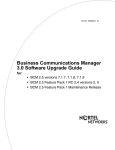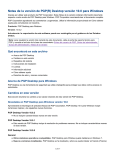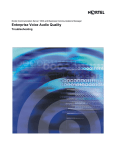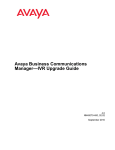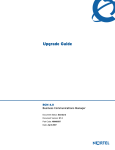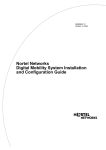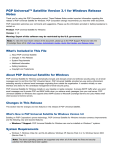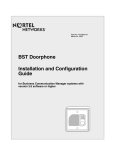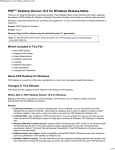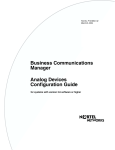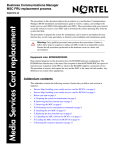Download Avaya Business Communications Manager 3.7 Upgrade Guide
Transcript
Part No. N0008594 01 April 7, 2005 Business Communications Manager 3.7 Upgrade Guide For systems running: • BCM 3.5 (build 2.3a or 2.3b) • BCM 3.6 (2.2c with cumulative patch 1) • BCM 3.7 (beta releases) Must read: • Prerequisites on page 8 • Post-upgrade instructions on page 15 Important notices: • A password change (ee_admin) is not required before performing this upgrade. If you do change any passwords before the upgrade, ensure that you perform a system reboot from the Unified Manager menu before you begin the upgrade. • If you have point-to-point protocol over Ethernet (PPPoE), see the warning on page 9. • If you have voice over IP (VoIP) trunks, review the VoIP trunks bullets on page 10. 2 How to get help If you do not see an appropriate number in this list, go to www.nortelnetworks.com/support. USA and Canada Authorized Distributors - ITAS Technical Support Telephone: 1-800-4NORTEL (1-800-466-7835) If you already have a PIN Code, you can enter Express Routing Code (ERC) 196#. If you do not yet have a PIN Code, or for general questions and first line support, you can enter ERC 338#. Web site: http://www.nortelnetworks.com/support Presales Support (CSAN) Telephone: 1-800-4NORTEL (1-800-466-7835) Use Express Routing Code (ERC) 1063# EMEA (Europe, Middle East, Africa) Technical Support - CTAS Telephone: * European Freephone European Alternative/ United Kingdom Africa Israel 00800 800 89009 +44 (0)870-907-9009 +27-11-808-4000 800-945-9779 * Note: Calls are not free from all countries in Europe, Middle East or Africa Fax: 44-191-555-7980 email: [email protected] CALA (Caribbean & Latin America) Technical Support - CTAS Telephone: 1-954-858-7777 email: [email protected] APAC (Asia Pacific) Technical Support - CTAS Telephone: +61-2-870-8800 Fax: +61 388664644 email: [email protected] In-country toll free numbers Australia 1800NORTEL (1800-667-835) China 010-6510-7770 India 011-5154-2210 N0008594 01 3 Indonesia 0018-036-1004 Japan 0120-332-533 Malaysia 1800-805-380 New Zealand 0800-449-716 Philippines 1800-1611-0063 Singapore 800-616-2004 South Korea 0079-8611-2001 Taiwan 0800-810-500 Thailand 001-800-611-3007 Service Business Centre & Presales Help Desk +61-2-8870-5511 Business Communications Manager 3.7 Upgrade Guide 4 N0008594 01 5 Contents How to get help 2 Chapter 1 Before you begin this upgrade 7 How to use this upgrade guide 7 First step 7 Second step 7 Final step 7 Which upgrade do I do? 8 Prerequisites to the upgrade 8 Important information to note before attempting this upgrade 8 Business Communications Manager pre-upgrade requirements 9 Hardware status 9 Business Communications Manager operations requirements 9 Client computer upgrade prerequisites 10 Pre-upgrade record-keeping tasks 11 Perform BRU on all data 12 Upgrade overview 13 During upgrade 14 Voice inventory service 14 Upgrade Wizard BCM status LEDs 14 Post-upgrade activities 15 Post-upgrade: all system upgrades 15 Post-upgrade: NetIQ Vivinet Manager service 16 Post-upgrade: Upgrading clients 17 New Reporting for Call Center client 17 Uninstalling a client application 17 Installing a client application 17 Chapter 2 Upgrading a BCM 3.5 or 3.6 system to BCM 3.7 19 Pre-upgrade readiness check 20 Upgrade application overview 21 Chapter 3 Upgrading pre-release BCM 3.7 software 31 Pre-upgrade readiness check 32 Upgrade application overview 33 Performing the upgrade 34 Business Communications Manager 3.7 Upgrade Guide 6 Chapter 4 Troubleshooting upgrade errors 43 Upgrade startup 43 Business Communications Manager identification 43 Business Communications Manager validation 45 Upgrade keycode 48 File transfer 48 General errors 49 N0008594 01 READ ME FIRST: Common prerequisites and processes 7 Chapter 1 Before you begin this upgrade Use this document to guide you through the steps that are required to upgrade any Business Communications Manager (BCM) system running BCM 3.5 or newer software to Business Communications Manager version 3.7 software. There are two upgrade paths. You choose which upgrade path to follow based on the current hardware and software configuration of your system. Ensure that you read the information in this chapter carefully before you turn to a specific upgrade. How to use this upgrade guide This section explains how to use the information in this guide. First step • Read the sections in this chapter that explain which upgrade you need to do (“Which upgrade do I do?” on page 8), and the common prerequisites and pre-upgrade requirements (“Prerequisites to the upgrade” on page 8). Any activities that are specific to just one type of upgrade will be noted. Ensure that you read all the instructions carefully before attempting to run the upgrade. • Also refer to the Process map to see the order in which the activities occur (“Upgrade overview” on page 13). • Once you read this information and ensure that your system is ready to be upgraded, go to the Second step. Second step Read the two sections under “During upgrade” on page 14 in this chapter. The first section describes a solution to a problem that can occur during the system check. The second section describes how the LEDs, which appear on the final upgrade screen, function during the upgrade. The upgrade chapters contain specific upgrade information. Each of these chapters describes: • which version of Business Communications Manager software will allow the upgrade • any specific pre-installation warnings • the process the upgrade goes through for the type of upgrade you are doing • step-by-step instructions to guide you through the upgrade Error dialogs may occur during the upgrade. Refer to “Troubleshooting upgrade errors” on page 43 for explanations of the error dialogs. When the upgrade completes successfully, go to the Final step. Final step After the successful upgrade, turn back to this chapter and go to the section that discusses post-upgrade activities (“Post-upgrade activities” on page 15). Not all of these activities apply to your system, but review them, then perform the required activities. Business Communications Manager 3.7 Upgrade Guide 8 Chapter 1 Before you begin this upgrade Which upgrade do I do? There are two upgrade paths. Choose which path to follow based on the software and hardware currently installed in your Business Communications Manager: • The first upgrade path, described in Chapter 2, “Upgrading a BCM 3.5 or 3.6 system to BCM 3.7,” on page 19, involves upgrading systems running BCM 3.0 (version 4), BCM 3.0.1 (build 7), BCM 3.5 (build 2.3a or 2.3b), or BCM 3.6 release software to BCM 3.7 software. • The second upgrade path, described in Chapter 3, “Upgrading pre-release BCM 3.7 software,” on page 31, describes how to upgrade systems that are running BCM 3.7 beta software (version 1.1 or 1.4) to the BCM 3.7 release software. Prerequisites to the upgrade Note: During the upgrade, your Business Communications Manager system, including the telephony services, is not functional. Before you attempt to perform the upgrade, review the following prerequisites carefully to determine whether your system is compliant. A verification process runs at the beginning of the upgrade. The verification process provides a system summary. If you are missing any requirements, the upgrade provides an error describing the deficiency. The upgrade does not continue until the validation runs error-free. If you are unable to correct the issue, contact your service manager for information. Important information to note before attempting this upgrade The following section provides notes and warnings for information that is critical to the upgrade. Warning: A password change (ee_admin) is not required before performing this upgrade. If you do change any passwords before the upgrade, ensure that you perform a system reboot from the Unified Manager menu before you begin the upgrade. Note: Keycodes This upgrade procedure requires a keycode. The upgrade keycode is entered into the Upgrade Wizard during the upgrade process. Keycodes are specific to a release. If you obtained a keycode to perform beta testing of the upgrade, you must obtain a new keycode to run the GA version of the upgrade release. Each upgrade release is only valid for a limited time after release. N0008594 01 Chapter 1 Before you begin this upgrade 9 Warning: PPPoE and IPX routing These settings are removed by the upgrade. Internetwork packet exchange (IPX) is not supported in release 3.6 or 3.7. Point-to-point protocol over Ethernet (PPPoE) must be reinstalled and reconfigured as part of the post-upgrade tasks. Call your technical services provider if you require more detailed instructions about these applications. Note: VoIP trunks: If your system has configured Voice over IP (VoIP) trunks, and at least one of the systems is running BCM 3.5 or newer software, a Quality of Service (QoS) patch was installed at the time of that upgrade or installation. You must install a QoS patch to any systems in your network running 3.0 or 3.0.1 software that you do not intend to upgrade to 3.7. You must disable the VoIP trunks to any systems that have not been upgraded to 3.7 and have not had the QoS patch installed. The QoS Patch supports H.323 version 4, which was introduced in BCM 3.5 software. Upgrade note: Systems running 3.0/3.0.1 must be upgraded to BCM 3.6 before they can be upgraded to BCM 3.7. If the system has VoIP connections to a Meridian 1, confirm that the Meridian is running Internet protocol for telephony (IPT) software. Business Communications Manager pre-upgrade requirements The following are requirements pertaining to your Business Communications Manager condition prior to the upgrade. Hardware status • Hard disk drive: Nortel Networks 20GB with correct partition sizes • 256 MB RAM • BCM1000/BCM400: MSC 1A Media Services Card (MSC) with four MS-PEC 1s, two MS-PEC IIIs, or four MS-PEC IIIs • BCM200: MSC 1B Media Services Card with one or two MS-PEC IIIs installed Business Communications Manager operations requirements • Note the IP address of the Business Communications Manager system that you want to upgrade. Warning: Current settings will be lost if there is a system failure during the upgrade procedure. Use BRU to back up all the data on the BCM and store it on a remote host before proceeding with the upgrade procedure. • Ensure that your Business Communications Manager primary network is on the same network as the computer you will use to run the upgrade. We strongly recommend that you use a computer that is within the same subnet as the Business Communications Manager system that you are upgrading. Ensure that the network connection is through the primary NIC (LAN) card. Business Communications Manager 3.7 Upgrade Guide 10 Chapter 1 Before you begin this upgrade • Ensure that FTP service is enabled on the Business Communications Manager and can be started remotely. • VoIP trunks: Ensure the QoS patch has been installed on all network Business Communications Managers running BCM 3.0/3.0.1 software that will not be upgraded to BCM 3.7 software, or disable the VoIP trunks to these systems until those systems are upgraded or the patch is installed. Refer to the note under “Important information to note before attempting this upgrade” on page 8. • Remove any mapped drives that may be connecting to the Business Communications Manager. • Client applications: All services will be down for the duration of the actual upgrade process. However, no other settings or mailboxes are affected by the upgrade. All applications should be fully functional once the system has rebooted and restarted services. All client applications will need to be reinstalled after the upgrade is complete. Note: Attendant Console was discontinued, starting in the BCM 3.5 release. Client computer upgrade prerequisites On the computer you will use to run the upgrade, ensure that the following requirements have been met: • Hardware and network requirements — Operating system: Windows 95, Windows 98, Windows ME, Windows NT, Windows 2000, or Windows XP — Use at least a 24X CD-ROM drive to minimize the upgrade time — Minimum screen resolution: 640X480 or greater. Suggested: 1024X768 — Minimum 256 colors — Free space on your hard disk (at least 50 MB) — Browser: Internet Explorer 5.5 or greater — Ensure that your computer is on the same network as your Business Communications Manager primary network. We strongly recommend that you use a computer that is within the same subnet as the Business Communications Manager system that you are upgrading. Ensure that the network connection is through the primary NIC (LAN) card. Note: If there are concerns about network performance, use a crossover cable connection to the LAN 1 adapter. This latter configuration provides the fastest possible file transfer. • Computer program requirements: — Ensure that you have Internet Explorer 5.5 or greater (suggested: IE 6.0). — If you have a personal firewall, such as CyberArmor, ensure that you either turn it off, or enter the IP address and netmask of the Business Communications Manager in the file for allowed IP addresses. In CyberArmor, this is the Friends file. N0008594 01 Chapter 1 Before you begin this upgrade 11 • Application requirements — Log out of any VNC, Telnet, PuTTY (3.5 and newer systems) or Unified Manager sessions, and quit any open Windows applications. Caution: Do not open any Windows, VNC or Unified Manager sessions while you perform the upgrade. These sessions can interfere with the progress of the upgrade. Pre-upgrade record-keeping tasks The following information is not preserved by the upgrade process. Make note of the configurations so they can be re-entered once the upgrade is complete. • Attendant Console: BCM 3.6 software does not support this application. If this application is present on your system, you receive the following notice at the beginning of the upgrade: Attendant Console has been detected. Please see BCM 3.7 Upgrade Guide for more information before continuing. When this notice appears, click OK. Then, either continue the upgrade or exit the upgrade application. If you continue, the Attendant Console application and data will no longer be available after the upgrade. If you require an Attendant Console product for your business, you can obtain a substitute product from Convertec at a discount. Go to the following URL for more information: http://www.nortelnetworks.com/products/announcements/eol.html#jan. • Password note: The upgrade retains the existing complexity level for passwords. This ensures that all user accounts update correctly. • External files: Any files or programs placed on the Business Communications Manager that are not part of the default software may be removed during the upgrade and will not be reinstalled. This includes any files you have transferred using the Business Communications Manager FTP service. Ensure that you have these files and applications adequately documented so you can reinstall them after the upgrade is complete. • Policy records: Record any Policy information entered under Services, Policy Management. This information must be re-entered after the upgrade. • Push tasks: Make note of any scheduled BRU, Archlog or CDR push tasks. These must be re-entered after the upgrade. • Diagnostics/SSM: Sanity test setting (returns to default after upgrade). • Diagnostics/Watchdog: Logging setting (returns to default after upgrade). • Services/CDR: Record the CDR format and feature code in use. • PPPoE: If your system is using PPPoE, make note of the system settings. • IPX routing: WARNING: IPX routing is not supported by BCM 3.7 software. • Upgrading from BCM 3.5 software to BCM 3.7 software: — If your system has a universal power supply (UPS), you must reconfigure the device to the serial port. — If you have NetIQ installed, you must obtain a keycode to be able to access the service in BCM 3.6. Business Communications Manager 3.7 Upgrade Guide 12 Chapter 1 Before you begin this upgrade — Private Received Number lengths and OLIs: BCM 3.6 software introduced a differentiation between public and private received number lengths, and public and private outgoing line identification (OLI). — If the DN length and the Public Received Number length (target lines) are different, after the upgrade you must manually enter the Private Received Number (new field) for each of the assigned target lines on your system. You also must enter a Private OLI (new field) for each telephone. — If the DN length and the Public Received Number length are the same, as recommended for Meridian client defined network (MCDN) private networking, and the Public OLI is coordinated with this length, the Private Received Number length automatically populates with the same number as the Public Received Number length. The Private OLI auto-populates with the DN. — If the system is running with a digital private network signaling system (DPNSS) keycode, record the Private Received Number lengths, as they must be re-entered. Use the backup and restore utility (BRU) on all data Ensure that you have a complete current backup file stored in a location other than on the Business Communications Manager or the computer you are using to run the backup. This provides you with a backup of your most recent settings in the event of a system failure during the upgrade. Warning: Once the upgrade is complete, never attempt to restore using this backup. This backup is only to be used if the upgrade fails and your system is no longer functional. A BRU backup can only be restored to a system running the same software version from which the BRU was created. N0008594 01 Chapter 1 Before you begin this upgrade 13 Upgrade overview The overall upgrade process is similar for both upgrades. The following chart provides an overview of the process. Start here Have you read and confirmed prerequisites? No Read the prerequisites section and confirm your hardware and software. Refer to “Prerequisites to the upgrade” on page 8. Yes Is your system ready for the upgrade? No Call your technical support provider if you cannot resolve all issues. Upgrade process Yes Do you have a keycode for the upgrade? No Obtain a keycode for each system you intend to upgrade. Start the Upgrade Wizard and follow prompts. Upgrade Wizard runs system verification. Yes Set upgrade schedule. Perform a BRU on the system and store off the hard disk. Files transfer to empty partition on BCM hard disk. BIOS update New files swap into active partition. Did you No change the ee-admin password? (not required) Upgrade complete Yes Perform a reboot from the Unified Manager menu. Perform post-upgrade activities and test your system. Refer to “Post-upgrade activities” on page 15. Business Communications Manager 3.7 Upgrade Guide 14 Chapter 1 Before you begin this upgrade During upgrade “Voice inventory service” describes how to start the voice inventory service, which, if it is not running correctly, may produce false errors about the media services card (MSC) core telephony software. “Upgrade Wizard BCM status LEDs” describes the different states that can display on the LEDs that appear on the final upgrade screen. Voice inventory service During system verification, at the start of the upgrade, the upgrade may display errors about the MSC core telephony software, the media services processor expansion cards (MS-PEC) and the type of MSC. This may mean that the voice inventory service must be started. To confirm that the service is running: 1 Exit the upgrade. 2 Open the Unified Manager. 3 Click System. 4 On the top menu, click Tools and select Perform System Inventory. 5 Click on Tools again and select Display System Inventory. • • If the service is now running correctly, exit the Unified Manager and retry the upgrade. If the information is not presented correctly, reboot the BCM. Once the system is running again, display the inventory again to confirm that the service is now running. Upgrade Wizard BCM status LEDs The LEDS in the BCM Status box on the transfer/upgrade page will change as the transfer and upgrade processes move along. Refer to Figure 1 and Table 1. Figure 1 BCM status LED indicators LEDs indicate current state of BCM connectivity and service availability N0008594 01 Chapter 1 Before you begin this upgrade 15 Table 1 BCM status LEDs BCM Connection • indicates that the application is connected to the Business Communications Manager and can communicate with it. • appears during any reboot that occurs during the upgrade. appears if the network connection is disconnected between your computer and the Business Communications Manager. appears if the Business Communications Manager is powered down or in the middle of a power cycle. appears during the portion of the upgrade from the point when the network settings are reset to default values until the configured values are restored. • • • LEDs BCM Services *Green • indicates that the Business Communications Manager is functioning and is providing all expected capabilities. Red • appears during periods when there is no access to services on the Business Communications Manager. appears any time the BCM Connection LED is red. appears once the system modifications begin. It remains red until the upgrade is complete and all the services have restarted. • • * At the end of a successful upgrade, both LEDs are green. Post-upgrade activities The following section contains a list of activities that must be performed once the upgrade is complete. Note: You may not need do all of these activities. Not all systems use all the functions listed below. Post-upgrade: all system upgrades • Back up data: As soon as you confirm that the system is operating as expected, perform a BRU to back up all data. This is now your current backup. • Push tasks: Reprogram any scheduled BRU, Archlog or CDR push tasks. (Management User Guide) • Policy record: Reconfigure the Policy settings that you noted before the upgrade. (Services, Policy Management) • Firewall record: If Firewall Filter logging is required, reset it to Enabled. (Programming Operations Guide) • Diagnostics, SSM: Reset the sanity test setting if it needs to be enabled. • Diagnostics, Watchdog: Reset the Logging setting, if required. • Services, CDR: Reset the format and feature code. • Client applications: Some of the client applications have new versions. Refer to “Post-upgrade: Upgrading clients” on page 17. If you wish to continue to use Telnet to access the command line interface, or if you have DECT modules, enable Telnet. (Programming Operations Guide) • DECT portable handsets: If the system uses DECT handsets, refer to the DECT Installation and Maintenance Guide for the procedure to update the DECT firmware (DECT wizard). Business Communications Manager 3.7 Upgrade Guide 16 Chapter 1 Before you begin this upgrade • Remote files: Re-enter any non-default files or programs that you noted before the upgrade, and which were removed during the upgrade. This includes any files you transferred to the Business Communications Manager using the Business Communications Manager FTP service. • Last-minute revisions: Read the documentation addendum for any last-minute issues that may need addressing with the new software. • PPPoE: If the system uses PPPoE, reinstall and reconfigure with the settings that you noted before the upgrade. • Received number lengths and OLI changes: — If the system DN length and the Public Received Number length (target lines) on your system are different, after the upgrade enter the Private Received Number (new field) for each of the target lines. Also, enter the Private OLI for each of the telephones. If the Private Received Number length and the Private OLI are not populated, the MCDN private networks cannot support CLID. — If the system uses a DPNSS keycode, enter new Private Received Number lengths. Post-upgrade: NetIQ Vivinet Manager service There are two main upgrade scenarios for the NetIQ application. • BCM 3.6 systems with NetIQ installed and the service is active, upgraded to BCM 3.7 software. In this case, existing settings are retained by the upgrade. However, to provide full functionality, including the ability to start or stop the application through the Unified Manager NetIQ heading, you must obtain a NetIQ keycode and enter it after the upgrade is finished. If you choose not to enter a NetIQ keycode, the NetIQ agent services run after the upgrade, but if the user disables the NetIQ agent, it cannot be re-enabled. If the user configures the server IP address and ports, the server IP address and ports are changed, but the NetIQ agent cannot be enabled after the NetIQ parameter modification. • BCM 3.6 systems where NetIQ Vivinet Manager support is inactive, upgraded to BCM 3.7 software. In this case, the Unified Manager NetIQ dialog displays the default settings for the service in the following fields: — — — — Authorized Management Servers is blank Bind Management Server Port defaults to 9998 NetIQ Agent Listening Port defaults to 9999 Status reads as Disabled. You can change these settings. However, to enable the NetIQ service, you must obtain and enter a NetIQ keycode. Note: NetIQ Service is not supported in a direct upgrade from BCM 3.5 to BCM 3.7, as the NetIQ Service was not fully operational until BCM 3.6. N0008594 01 Chapter 1 Before you begin this upgrade 17 Post-upgrade: Upgrading clients After you upgrade Business Communications Manager, follow these procedures to upgrade Business Communications Manager clients on each subscriber computer. Every client must be upgraded. Depending on the expertise of the subscriber, you can ask them to upgrade the clients. New Reporting for Call Center client Use the new Reporting for Call Center client to connect to the upgraded Business Communications Manager system to create and work with new reports. Warning: Do not uninstall the Reporting for Call Center client installed in BCM 3.6 from your computer if you need to view or print reports currently stored on your computer. For details on the Reporting to Call Center client installed in BCM 3.6, refer to the Reporting to Call Center upgrade document, included in the BCM 3.6 documentation suite. Uninstalling a client application To uninstall the client applications before installing the new versions: Warning: Call Detail Recording Do not uninstall earlier versions of Call Detail Recording when installing new versions. 1 On the client computer, click the Start button, select Settings and click Control Panel. The Control Panel window appears. 2 Double-click the Add/Remove Programs icon. The Add/Remove Programs Properties dialog box appears. 3 From the list of installed programs, select the program you want to uninstall. 4 Click the Add/Remove button. The program indicates when the uninstall is complete. Installing a client application To install the new version of the application: 1 On the Unified Manager main page, click the Install Clients button. The Download Client Applications page appears. 2 Download the desktop clients according to the instructions on the Download Client Applications page. 3 Configure the clients according to your system documentation. Business Communications Manager 3.7 Upgrade Guide 18 Chapter 1 Before you begin this upgrade N0008594 01 Upgrade steps for systems running BCM 3.5 or 3.6 software 19 Chapter 2 Upgrading a BCM 3.5 or 3.6 system to BCM 3.7 Use this document to guide you through the steps that are required to upgrade to BCM 3.7 software from the following BCM software versions: • BCM 3.5 (version 2.3a or 2.3b) • BCM 3.6 (version 2.2c with cumulative patch 1) This upgrade requires the upgrade keycode that is specific to the released software. Warning: PPPoE and IPX routing The upgrade removes these settings. Internetwork packet exchange (IPX) is not supported by BCM 3.7 software. Point-to-point protocol over Ethernet (PPPoE) must be reinstalled and reconfigured after the upgrade. Ensure that you read all the instructions in this chapter carefully before attempting to run the upgrade. Warning: After you upgrade your Business Communications Manager system to BCM 3.7 software, your system cannot be changed back to the previous version. This chapter contains the following sections: • “Pre-upgrade readiness check” on page 20 • “Upgrade application overview” on page 21 • “Performing the upgrade” on page 22 If you have not already done so, read all the instructions in “Prerequisites to the upgrade” on page 8 before continuing with these instructions. Warning: Perform a data backup before starting You must perform a backup and restore (BRU) on your system before you attempt the upgrade. Store the information off the hard disk of the Business Communications Manager and off the computer you use to perform the upgrade. Warning: Perform a data backup after successful upgrade. You must perform a BRU on your upgraded system right after the upgrade completes as part of your system integrity process. You cannot restore data from a previous version. Store the information off the hard disk of the Business Communications Manager and off the computer you use to perform the upgrade. SRG note: Systems configured as Survivable Remote Gateways (SRG) must be running BCM 3.6 version 1.1 or 1.4 software to be able to run an upgrade that preserves SRG information. Business Communications Manager 3.7 Upgrade Guide 20 Chapter 2 Upgrading a BCM 3.5 or 3.6 system to BCM 3.7 Pre-upgrade readiness check Use this flowchart to ensure that your system is ready for the upgrade. You have the appropriate BCM 3.7 upgrade kit. Is your system running BCM 3.5, version 2.3a or 2.3b or BCM 3.6, version 2.2c? No Yes Did you read and comply with the prerequisites? No If your system is running BCM 2.5 or earlier software, contact your service representative and order a 3.0.1 upgrade kit. If your system is running 3.0 or 3.0.1 software, contact your service representative and order a 3.6 upgrade kit. If your system is running software that is not the correct version, contact your system support for further instructions. Refer to the information in Chapter 1. Specifically, read “Prerequisites to the upgrade” on page 8. Yes Do you have the correct keycode for the upgrade? No Obtain the keycode. There are separate keycodes for pre-release and released upgrade software. Yes Did you make a backup of the system data? Yes Go to “Performing the upgrade” on page 22. N0008594 01 No Perform a BRU on your system. Store the files off the BCM and off the computer you will use for the upgrade. Note: You cannot use these files once the BCM upgrade is complete. They are meant to ensure that you can restore your data if the upgrade cannot complete. To preview the upgrade process, refer to “Upgrade application overview” on page 21. Chapter 2 Upgrading a BCM 3.5 or 3.6 system to BCM 3.7 21 Upgrade application overview The Business Communications Manager 3.7 upgrade application includes the following steps: Note: The upgrade process takes 60 to 90 minutes to complete. The system services are down during that period, so ensure that you notify your users of the outage. 1 To start the upgrade, enter a username and password. Ensure that the username you use has supervisor privileges. Business Communication Manager performs a system validation, including version checking, disk capacity checking, and so on. The Business Communications Manager 3.7 Upgrade Wizard first accesses your system to validate the software requirements. Note: Voice Inventory service The BCM 3.7 upgrade may present false errors about the media services card (MSC) Core Telephony Software, the media services processor expansion cards (MS-PEC), and the type of MSC if the Voice Inventory service has not been started. Confirm that this service is running: Enter the Unified Manager and click on System. On the top menu, click on Tools, and select Perform System Inventory. Then go back under Tools and select Display System Inventory. This indicates that the service is running correctly. 2 Once the validation is complete, enter an upgrade keycode. Keycodes are obtained from the same source, and in the same manner, as other system keycodes. However, the upgrade keycode is entered in the Upgrade Wizard rather than in the Unified Manager. Refer to Figure 4 on page 24. Note: This keycode is different from the one you used to perform upgrades with the pre-release upgrade software. 3 Validate hardware requirements. 4 Transfer Business Communications Manager 3.7 software image to the target Business Communications Manager. 5 Perform a system initialization. 6 Start services and verify proper operation. Note: During this process, the Business Communications Manager reboots multiple times. When the upgrade is complete, the Upgrade Wizard presents a dialog box indicating that the upgrade is successful and complete. If you receive any error messages during system verification or during the upgrade, refer to “Troubleshooting upgrade errors,” on page 43. Business Communications Manager 3.7 Upgrade Guide 22 Chapter 2 Upgrading a BCM 3.5 or 3.6 system to BCM 3.7 Performing the upgrade You are now ready to start the upgrade. Warning: Do not disturb the upgrade once it starts. This could result in data loss or other system failures. 1 Insert the upgrade CD marked Disk 1 into your CD-ROM drive. • If your CD-ROM drive is configured to run automatically, the first page appears. • If your CD-ROM drive does not run automatically, run Startup.bat. (On Windows, click Start, choose Run, enter <CD drive letter>:Startup.bat, then click OK.) The Welcome page of the Upgrade Wizard appears. Refer to Figure 2. Figure 2 Upgrade Wizard Welcome page 2 Read the information carefully so that you understand the upgrade process. This page explains how the upgrade process works. N0008594 01 Chapter 2 Upgrading a BCM 3.5 or 3.6 system to BCM 3.7 23 3 Click the I Accept button to proceed with the upgrade. The sign-in page appears, as shown in Figure 3. Figure 3 Identifying the system you want to upgrade 4 Enter the IP address of the Business Communications Manager being upgraded. The IP address format is xxx.xxx.xxx.xxx; press the space bar to move between fields. 5 Enter the Username* and Password* for your system. *Use an administrator-level username and password. 6 Click Next. The system performs some validations and then presents the screen shown in Figure 4 on page 24. Note: Figure 4 on page 24 provides an example of how your system’s IP address and system ID are displayed. Business Communications Manager 3.7 Upgrade Guide 24 Chapter 2 Upgrading a BCM 3.5 or 3.6 system to BCM 3.7 Figure 4 Enter upgrade keycode 7 Enter the keycode you obtained for your system. a Click the Next button if you are ready to proceed. If you entered the keycode incorrectly, you receive the error dialog box shown in Figure 5. Click OK and check your entry. Figure 5 Invalid Keycode. b Click the Exit button, shown in Figure 4, if you did not obtain a keycode, or did not obtain a keycode for this specific system. You cannot proceed with the upgrade without the correct keycode. Once you have the correct keycode, restart the upgrade process. c Click the How do I get a Keycode? button, shown in Figure 4, if you are uncertain about how to obtain a keycode. Once you have the correct keycode, restart the upgrade process. N0008594 01 Chapter 2 Upgrading a BCM 3.5 or 3.6 system to BCM 3.7 25 8 Once you click the Next button, the upgrade program performs a system validation to ensure that your system is ready to receive the upgrade. The wizard provides indicators of the various activities it performs to set up and run the verification tool. If you receive any error messages during the verification process, refer to “Business Communications Manager validation” on page 45 for more details about the error. When the verification completes: a If verification is unsuccessful, you receive an error message describing what is missing from your system. In this case, click OK on the dialog box, and then click Exit on the wizard page. Correct the problem before attempting to repeat the upgrade. b If the verification is successful, the page shown in Figure 6 appears. This page shows you a snapshot of the system information. Note: BIOS update If you are using BCM200 or BCM400, the motherboard on the system may require a BIOS update. The update runs automatically if it is required. Figure 6 Screen showing system information and Begin Upgrade box 9 Click the Begin button on the screen shown in Figure 6 when you are ready to continue the upgrade. Business Communications Manager 3.7 Upgrade Guide 26 Chapter 2 Upgrading a BCM 3.5 or 3.6 system to BCM 3.7 See Figure 7 on page 26 for the dialog box you receive to confirm that you want to continue the upgrade. Figure 7 Final Confirmation Before Upgrade Begins 10 Click the Yes button to continue the upgrade. The screen shown in Figure 8 on page 27 appears. As each action of the upgrade completes, the listing in the Action and Status turns from blue to green and a checkmark appears beside it. Note that the Update Bios line does not appear on upgrades to BCM1000 systems or any BCM 200/400 system that does not require the BIOS upgrade. If there are problems with any step, an error message dialog box appears and describes the problem (“Troubleshooting upgrade errors” on page 43). N0008594 01 Chapter 2 Upgrading a BCM 3.5 or 3.6 system to BCM 3.7 27 Figure 8 Upgrade action screen 11 A secondary dialog box, shown in Figure 9, appears during the Transfer Files to BCM action. This box shows the progress of the files being copied to the BCM. Warning: Pressing Cancel during file transfers renders your Business Communications Manager out-of-service until the upgrade is restarted and completed. Use only if severe network problems are occurring. Figure 9 Transferring Disk 1 Files 12 Remove Disk 1 from the CD drive and insert the second upgrade CD (Disk 2) into the drive when the dialog box shown in Figure 10 appears. Business Communications Manager 3.7 Upgrade Guide 28 Chapter 2 Upgrading a BCM 3.5 or 3.6 system to BCM 3.7 The upgrade copies the files from the CD onto the BCM. Note: If the files are located on a server or your computer, press the Browse button to locate the file for Disk 2; then, click OK to continue. Figure 10 Insert CD 13 Click OK to continue. Once the files are transferred, the upgrade continues. The system reboots multiple times before the upgrade is complete. When the upgrade completes, the dialog box shown in Figure 11 on page 28 appears and the Overall Progress bar, shown in Figure 8 on page 27, shows 100%. Figure 11 Successful upgrade completion indicator 14 Click OK to exit the dialog box. 15 Confirm that both BCM Status LEDs on the Upgrade Wizard screen are green. 16 To exit the Upgrade Wizard, click the Close box at the right upper corner of the BCM Upgrade Wizard screen shown in Figure 12 on page 29. N0008594 01 Chapter 2 Upgrading a BCM 3.5 or 3.6 system to BCM 3.7 29 Figure 12 Final upgrade screen with green BCM status LEDs Close screen BCM is operational 17 Perform the post upgrade activities that apply to your system shown in “Post-upgrade activities” on page 15. Business Communications Manager 3.7 Upgrade Guide 30 Chapter 2 Upgrading a BCM 3.5 or 3.6 system to BCM 3.7 N0008594 01 Upgrade steps for systems running BCM 3.7 beta 1.1 or 1.4 software 31 Chapter 3 Upgrading pre-release BCM 3.7 software Use this document to guide you through the steps that are required to upgrade any Business Communications Manager running BCM 3.7 version beta software to the released version of the software. This upgrade requires the upgrade keycode that is specific for the released software. Warning: PPPoE and IPX routing The upgrade removes these settings. Internetwork packet exchange (IPX) is not supported by BCM 3.7 software. Point-to-point protocol over Ethernet (PPPoE) must be reinstalled and reconfigured after the upgrade. Ensure that you read all the instructions in this chapter carefully before attempting to run the upgrade. This chapter contains the following sections: • “Pre-upgrade readiness check” on page 32 • “Upgrade application overview” on page 33 • “Performing the upgrade” on page 34 If you have not already done so, read all the instructions in “Prerequisites to the upgrade” on page 8 before continuing with these instructions. Warning: Perform a data backup before starting You must perform a BRU on your system before you attempt the upgrade. Store the information off the hard disk of the Business Communications Manager and off the computer you use to perform the upgrade. Warning: Perform a data backup after successful upgrade. You must perform a BRU on your upgraded system right after the upgrade completes as part of your system integrity process. You cannot restore data from a previous version. Store the information off the hard disk of the Business Communications Manager and off the computer you use to perform the upgrade. SRG note: Systems configured as Survivable Remote Gateways (SRG) must be running BCM 3.6 version 1.1 or 1.4 software to support an upgrade that preserves SRG information. Business Communications Manager 3.7 Upgrade Guide 32 Chapter 3 Upgrading pre-release BCM 3.7 software Pre-upgrade readiness check Use this flowchart to ensure that your system is ready for the upgrade. You have the appropriate BCM 3.7 upgrade kit. Is your system running BCM 3.7 (beta release) software. No Yes Did you read and comply with the prerequisites? No If your system is running BCM 2.5 or earlier software, contact your service representative and order a 3.0.1 upgrade kit and a 3.6 upgrade kit. If your system is running BCM 3.0 or 3.0.1 software, contact your service representative and order a 3.6 upgrade kit. If your system is running BCM 3.5 or BCM 3.6 software, refer to “Upgrading a BCM 3.5 or 3.6 system to BCM 3.7” on page 19. If your system is running a BCM 3.7 software version other than the beta release, contact your service representative for more information. Refer to the information in Chapter 1. Specifically, read “Prerequisites to the upgrade” on page 8. Yes Do you have the correct keycode for the upgrade? No Obtain the release keycode. There are separate keycodes for pre-release and released upgrade software. Yes Did you make a backup of the system data? Yes Go to “Performing the upgrade” on page 34. N0008594 01 No Perform a BRU on your system. Store the files off the BCM and off the computer you will use for the upgrade. Note: These files are meant to ensure that you can restore your data if the upgrade cannot complete. To preview the upgrade process, refer to “Upgrade application overview” on page 33. Chapter 3 Upgrading pre-release BCM 3.7 software 33 Upgrade application overview The Business Communications Manager 3.7 upgrade application includes the following steps: Note: The upgrade process takes 60 to 90 minutes to complete. The system services are down during that period, so ensure that you notify your users of the outage. 1 To start the upgrade, enter a username and password. Ensure that the username you use has supervisor privileges. Business Communication Manager performs a system validation, including version checking, disk capacity checking, and so on. The Business Communications Manager 3.7 Upgrade Wizard first accesses your system to validate the software requirements. Note: Voice Inventory service The BCM 3.7 upgrade may present false errors about the media services card (MSC) Core Telephony Software, the media services processor expansion cards (MS-PEC), and the type of MSC if the Voice Inventory service has not been started. Confirm that this service is running: Enter the Unified Manager and click on System. On the top menu, click on Tools, and select Perform System Inventory. Then go back under Tools and select Display System Inventory. This indicates that the service is running correctly. 2 Once the validation is complete, enter an upgrade keycode. Keycodes are obtained from the same source, and in the same manner, as other system keycodes. However, the upgrade keycode is entered in the Upgrade Wizard rather than in the Unified Manager. Refer to Figure 15 on page 36. Note: This keycode is different from the one you used to perform upgrades with the pre-release upgrade software. 3 Validate hardware requirements. 4 Transfer Business Communications Manager 3.7 software image to the target Business Communications Manager. 5 Perform a system initialization. 6 Start services and verify proper operation. Note: During this process, the Business Communications Manager reboots multiple times. When the upgrade is complete, the Upgrade Wizard presents a dialog box indicating that the upgrade is successful and complete. If you receive any error messages during system verification or during the upgrade, refer to “Troubleshooting upgrade errors,” on page 43. Business Communications Manager 3.7 Upgrade Guide 34 Chapter 3 Upgrading pre-release BCM 3.7 software Performing the upgrade You are now ready to start the upgrade. Warning: Do not disturb the upgrade once it starts. This could result in data loss or other system failures. 1 Insert the upgrade CD marked Disk 1 into your CD-ROM drive. • If your CD-ROM drive is configured to run automatically, the first page appears. • If your CD-ROM drive does not run automatically, run Startup.bat. (On Windows, click Start, choose Run, enter <CD drive letter>:Startup.bat, then click OK.) The Welcome page of the Upgrade Wizard appears. Refer to Figure 13. Figure 13 Upgrade Wizard Welcome page 2 Read the information carefully so that you understand the upgrade process. This page explains how the upgrade process works. 3 Click the I Accept button to proceed. The system may go through some configuration steps, and then the sign-in page appears, as shown in Figure 14. N0008594 01 Chapter 3 Upgrading pre-release BCM 3.7 software 35 Figure 14 Identifying the system you want to upgrade 4 Enter the IP address of the Business Communications Manager being upgraded. The IP address format is xxx.xxx.xxx.xxx; press the space bar to move between fields. 5 Enter the Username* and Password* for your system. *Use an administrator-level username and password. 6 Click Next. The system performs some validations and then presents the screen shown in Figure 15 on page 36. Note: Figure 15 on page 36 provides an example of how your system’s IP address and system ID are displayed. Business Communications Manager 3.7 Upgrade Guide 36 Chapter 3 Upgrading pre-release BCM 3.7 software Figure 15 Enter upgrade keycode 7 Enter the keycode you obtained for your system. a Click the Next button if you are ready to proceed. If you entered the keycode incorrectly, you receive the error dialog box shown in Figure 16. Click OK and check your entry. Figure 16 Invalid Keycode. b Click the Exit button, shown in Figure 15, if you did not obtain a keycode, or did not obtain a keycode for this specific system. You cannot proceed with the upgrade without the correct keycode. Once you have the correct keycode, restart the upgrade process. c Click the How do I get a Keycode? button, shown in Figure 15, if you are uncertain about how to obtain a keycode. Once you have the correct keycode, restart the upgrade process. N0008594 01 Chapter 3 Upgrading pre-release BCM 3.7 software 37 8 Once you click the Next button, the upgrade program performs a system validation to ensure that your system is ready to receive the upgrade. The wizard provides indicators of the various activities it performs to set up and run the verification tool. If you receive any error messages during the verification process, refer to “Business Communications Manager validation” on page 45 for more details about the error. When the verification completes: a If verification is unsuccessful, you receive an error message describing what is missing from your system. In this case, click OK on the dialog box, and then click Exit on the wizard page. Correct the problem before attempting to repeat the upgrade. b If the verification is successful, the page shown in Figure 17 appears. This page shows you a snapshot of the system information. Figure 17 Screen showing system information and Begin Upgrade box 9 Click the Begin button on the screen shown in Figure 17 when you are ready to continue the upgrade. See Figure 18 on page 38 for the dialog box you receive to confirm that you want to continue the upgrade. Business Communications Manager 3.7 Upgrade Guide 38 Chapter 3 Upgrading pre-release BCM 3.7 software Figure 18 Final Confirmation Before Upgrade Begins 10 Click the Yes button to continue the upgrade. The screen shown in Figure 19 appears. As each action of the upgrade completes, the listing in the Action and Status columns turns from blue to green and a checkmark appears beside it. Note that the Update Bios line does not appear on upgrades to BCM1000 systems or any BCM 200/400 system that does not require the BIOS upgrade. If there are problems with any step, an error message dialog box appears and describes the problem (“Troubleshooting upgrade errors” on page 43). Figure 19 Upgrade action screen N0008594 01 Chapter 3 Upgrading pre-release BCM 3.7 software 39 11 A secondary dialog box, shown in Figure 20, appears during the Transfer Files to BCM action. This box shows the progress of the files being copied to the BCM. Warning: Pressing Cancel during file transfers renders your Business Communications Manager out-of-service until the upgrade is restarted and completed. Use only if severe network problems are occurring. Figure 20 Transferring Disk 1 Files 12 Remove Disk 1 from the CD drive and insert the second upgrade CD (Disk 2) into the drive when the dialog box shown in Figure 21 appears. The upgrade copies the files from the CD onto the BCM. Note: If the files are located on a server or your computer, press the Browse button to locate the file for Disk 2; then, click OK to continue. Figure 21 Insert CD 13 Click OK to continue. Once the files are transferred, the upgrade continues. The system reboots multiple times before the upgrade is complete. When the upgrade completes, the dialog box shown in Figure 22 on page 40 appears and the Overall Progress bar shown in Figure 19 on page 38 shows 100%. Business Communications Manager 3.7 Upgrade Guide 40 Chapter 3 Upgrading pre-release BCM 3.7 software Figure 22 Successful upgrade completion indicator 14 Click OK to exit the dialog box. 15 Confirm that both BCM Status LEDs on the Upgrade Wizard screen are green. 16 To exit the Upgrade Wizard, click on the Close box at the right upper corner of the BCM Upgrade Wizard screen shown in Figure 23 on page 40. Figure 23 Final upgrade screen with green BCM status LEDs Close screen BCM is operational N0008594 01 Chapter 3 Upgrading pre-release BCM 3.7 software 41 17 Perform the post-upgrade activities that apply to your system shown in “Post-upgrade activities” on page 15. Business Communications Manager 3.7 Upgrade Guide 42 Chapter 3 Upgrading pre-release BCM 3.7 software N0008594 01 43 Chapter 4 Troubleshooting upgrade errors There are a number of possible error conditions that may occur during the upgrade procedure. This chapter provides information about those error conditions. Refer to “How to get help” on page 2 if you are instructed to contact support. Upgrade start-up The following error messages appear when an inconsistency is discovered by the upgrade application. • If the upgrade definition file is corrupt: Could not find a valid upgrade definition file. This could be a bad CD containing corrupt data. Contact support for resolution. Recommended Action: There may be data missing, or the CD is damaged. Contact technical support for a valid upgrade CD. • If the evaluation upgrade software has exceeded the expiry date (30 days): This evaluation version of the upgrade has expired. Please contact support for an updated version. Recommended Action: Obtain the full release version, which has a longer expiry term. • If the upgrade software cannot confirm an expiry date because the upgrade definition file is corrupt: This upgrade could not determine expiry. Please contact support for resolution. Recommended Action: There may be data missing, or the CD is damaged. Contact technical support for a valid upgrade CD, because the upgrade cannot continue if the expiry cannot be determined. Business Communications Manager identification • Partition sizes on BCM200/400 hard disks must match the manufacturer’s specifications for the BIOS update to be successful. The following minimum partition sizes are checked: C: 2400 MB D: 9000 MB E: 2000 MB F: 2000 MB G: 2000 MB Business Communications Manager 3.7 Upgrade Guide 44 Chapter 4 Troubleshooting upgrade errors The following disk space is required: C: 140 MB D: 300 MB E: 200 MB Recommended Action: If you cannot match these specifications, contact technical support for assistance. • If you entered an invalid IP address or failed to enter an IP address before you pressed Next, you receive one of the following messages: You must specify an IP address You must enter a valid IP address Recommended Action: The upgrade requires a valid Business Communications Manager IP address. The IP address must be in a valid format between 0.0.0.1 and 255.255.255.254. Use the space bar to move to the next space. • If you entered an invalid username or password into the Upgrade Wizard screen: Connect failed. Invalid username or password Recommended Action: Confirm the username and password for the system, and then re-enter the username and password. • If the application cannot access a network to connect to your Business Communications Manager: Connect failed. Could not establish connection to network. Recommended Action: Exit the wizard and check your network connections; then, try again. • If the application cannot connect to your Business Communications Manager but cannot determine why: Connect failed. Please validate BCM information. Recommended Action: Check your Business Communications Manager system and network settings. Use Ping from your computer to test the validity of the IP address. • If the application cannot connect to the FTP server because the user does not have write permission: Failure to transfer files to BCM due to login failure. Contact support for resolution. Recommended Action: Contact technical support for resolution. • If the FTP server fails to start within a three-minute period: FTP server cannot be started. Contact support for resolution. N0008594 01 Chapter 4 Troubleshooting upgrade errors 45 Recommended Action: Contact technical support for resolution. Business Communications Manager validation • If the application determines that the software running on the Business Communications Manager cannot be upgraded (refer to “Upgrade overview” on page 13): The BCM version is unsupported for this upgrade. Please refer to the Business Communications Manager 3.7 Upgrade Guide for supported software releases. Recommended Action: Exit the upgrade. Through Unified Manager, determine which version is running on your system. Select System. On the menu bar, click Tools, then select Display System Inventory. The current version is displayed in the first table under Version. Refer to the recognized versions listed under “Upgrade overview” on page 13. Contact your technical support team for information. • If the MS-PEC configuration in your system does not match a supported configuration (refer to “Business Communications Manager pre-upgrade requirements” on page 9), you receive one of the following messages: The BCM has a problem with the MS-PECs. Please see the Business Communications Manager 3.7 Upgrade Guide for supported MS-PEC configurations. No PECs detected. Either bad PECs exist on the MSC card, the MSC card is not working properly, or an unsupported configuration has been installed. Please see the Business Communications Manager 3.7 Upgrade Guide for supported MS-PEC configurations. Only one PEC detected. Either a bad PEC exists on the MSC card, the MSC card is not working properly or an unsupported configuration has been installed. Please see the Business Communications Manager 3.7 Upgrade Guide for supported MS-PEC configurations. Only three PECs detected. Valid configurations are 4 PEC threes, 2 PEC threes or 4 PEC ones. Please ensure that all PECs are seated correctly. Please see the Business Communications Manager 3.7 Upgrade Guide for supported MS-PEC configurations. Recommended Action: Verify the status of the PECs. If your configuration is correct, this error may also indicate that there is a problem with one of the PEC cards. You can check on the status of the PEC cards on the Unified Manager. This information is found under Resources, Media Services Card, on the MS-PEC Information tab. Refer to Figure 24. Business Communications Manager 3.7 Upgrade Guide 46 Chapter 4 Troubleshooting upgrade errors Figure 24 MS-PEC information in the Unified Manager • If your system does not have the required 256 MB RAM installed: The BCM does not have sufficient memory. Only <memory size> detected. Please see the Business Communications Manager 3.7 Upgrade Guide for required memory configuration. Recommended Action: Exit the upgrade. You are unable to continue with the upgrade until you update the RAM in your Business Communications Manager base unit. Refer to the Business Communications Manager Installation Guide for information about replacing memory chips (RAM). • If your system has insufficient space on one or more of the hard disk drives on the Business Communications Manager, you receive one of the following messages: There is insufficient disk space on the BCM drive <drive letter>. Please see the Business Communications Manager 3.7 Upgrade Guide for disk space requirements on each drive. Recommended Action: Check available disk space. Use virtual network computing (VNC) to access the Business Communications Manager desktop to check the disk space available on each of the drive. — If C: drive requires additional disk space, contact your technical support. — If D: drive requires additional disk space, ask the voicemail subscribers to delete mailbox messages to free up space. — If E: drive requires additional disk space, delete any files you have added or any old data backups. If none of these remedies provides sufficient disk space, or if the verification continues to display the memory error message, contact your technical support for more information. • If your hard disk is partitioned incorrectly: The BCM drive <drive letter> is not partitioned correctly. Please see the Business Communications Manager 3.7 Upgrade Guide for disk partitioning requirements on each drive. Recommended Action: Exit upgrade. Call your technical support for assistance. N0008594 01 Chapter 4 Troubleshooting upgrade errors 47 • If your system has incorrect core telephony software: The MSC Core Telephony Software could not be properly recognized. Please confirm that the telephones connected to the BCM are functioning. The Business Communications Manager 3.7 Upgrade Guide contains further information. Recommended Action: Exit upgrade. The verification procedure requires a recognized version of MSC Core Telephony Software. If your system generates this error, contact your technical support for instructions about updating the Core Telephony software. Have the following information available when you call your technical support number: — confirmation that the telephones connected to the system are functioning correctly — a list of any software patches that have been applied to the Business Communications Manager • If your system date is set incorrectly: The BCM system date must be configured correctly before the BCM 3.7 upgrade will proceed. Please configure the BCM system date and restart the BCM 3.7 Upgrade. Please see the Business Communications Manager 3.7 Upgrade Guide for further information. Recommended Action: Go into the Unified Manager (System, Identification) and correct the date; then, restart the upgrade. • If one or more of your system services is missing or improperly configured: Missing Service: <service name> Recommended Action: Exit upgrade. You must have the service issues corrected before you can perform the upgrade. Contact your technical support services and provide them with the text of the error that was generated. • If the application does not get a complete response from the Business Communications Manager within a given time period (approx 1 minute): Timeout waiting for initial information from BCM. Action: Exit the upgrade and retry. • If the Business Communications Manager contains a problem that would prevent a successful upgrade: System Status Monitor registry key is corrupt or missing. Cannot continue validation. Recommended Action: Contact technical support for resolution. Business Communications Manager 3.7 Upgrade Guide 48 Chapter 4 Troubleshooting upgrade errors Upgrade keycode • If the keycode was passed to the system and failed to validate: Keycode could not be validated as correct for this system. Recommended Action: Verify and re-enter the keycode. • If one or more keycode edit box has been left empty (unless the edit box is grayed out, a keycode must be entered): A complete keycode must be supplied for this upgrade. Recommended Action: Use the space bar to move from box to box. • If either the software release or the keycode is out-of-date and a more recent one should be obtained: The keycode entered was valid but does not match the release of the software being used. Please contact support to resolve the problem. Recommended Action: Each separate release of the upgrade software uses a different keycode to enable the upgrade. Contact technical support to determine if a new software release or new keycode is required. • If the keycode you enter does not have a correct entry: A 24-digit keycode must be supplied for this upgrade. Recommended Action: Each keycode must have 24 digits, in three groups of eight. The cursor jumps automatically to the next box when eight characters have been entered. File transfer • If the files fail to transfer to the Business Communications Manager, you receive one of the following messages: SetFile TransferFail failed with errorlevel %errorlevel% - Please contact support and report this problem. File transfer failed - check network connection and media. Select Yes to retry or select No to abort the upgrade and contact support to report this problem. Recommended Action: Contact technical support unless there is some known network issue. N0008594 01 Chapter 4 Troubleshooting upgrade errors 49 • If you press Cancel on the file transfer dialog box as files are being transferred: Canceling a file transfer during an upgrade can cause serious upgrade issues. Do you really want to cancel this transfer? Recommended Action: Do not proceed with the cancellation unless network issues caused the transfer to halt. • If the copied files cannot be verified by the upgrade: File check failed after 3 attempts - please check upgrade media and network connections and contact support. Recommended Action: Contact technical support unless there is a known network issue. General errors • If any of the upgrade files are missing: Missing file %1. Please contact technical support and report this error. Upgrade is aborting. Recommended Action: Contact technical support. This is a critical error. • If an unexpected error occurs during the upgrade process, you may see one of the following messages: Error: %noext% completed but did not set an exit code - select OK to reboot and retry or Cancel to abort. %noext% failed with unknown exit code %RC% Could not create %noext% run command. Recommended Action: Retry, or contact technical support. • If one of the upgrade CDs with the help files is not installed in the CD tray when you attempt to access the Help menu: Cannot find help file. Please enter one of the Upgrade CD’s before opening the help screen. Recommended Action: Place one of the upgrade CDs in the CD tray on your computer. • If an upgrade process is unable to complete and is terminated by the upgrade application: <Process> hung and was terminated. Select Yes to retry or select No to abort the upgrade and contact support to report this problem. Business Communications Manager 3.7 Upgrade Guide 50 Chapter 4 Troubleshooting upgrade errors Recommended Action: Contact technical support. • If the upgrade completes but fails to exit correctly: <Process> completed but did not set an exit code. Select Yes to retry or select No to abort the upgrade and contact Recommended Action: Contact technical support. • If one or more services fail to restart within a given period after the upgrade: A service has failed to start after 3 attempts. Services up timed out. Recommended Action: Contact technical support. N0008594 01


















































